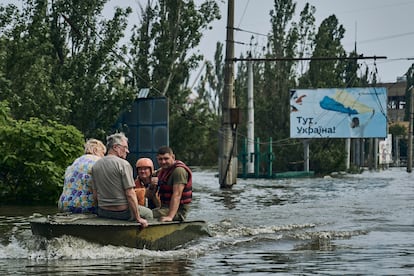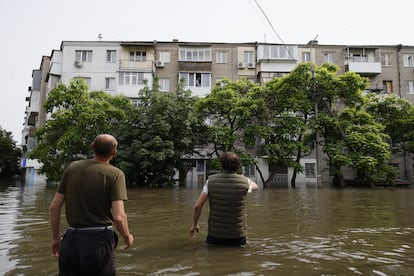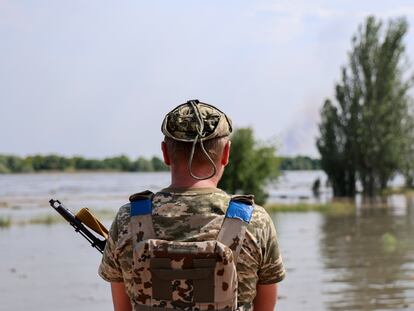Kherson’s few remaining citizens defiant in a city flooded by a militarized river: ‘We will resist, as we resisted the occupation’
The destruction of the Nova Kakhovka dam has further punished a population carrying on with their lives on the banks of the Dnipro, on the front line between Ukrainian and Russian forces


In another life, before the Russian invasion of Ukraine, the destruction of the Nova Kakhovka dam would have led to a mass evacuation of hundreds of thousands of people. But the villages that have been flooded along the final 60-kilometer (37 miles) stretch of the Dnipro River before it flows into the Black Sea have long since been virtually deserted. Kherson is a ghost town where death lurks on every street corner. Now, in addition to the potholes and ruined buildings caused by artillery fire, there are submerged neighborhoods where the few residents who remain have lost what little they had left.
The Ukrainian government estimates that on both banks of the flooded river, more than 40,000 people will need to be relocated. On the Ukrainian side, Kyiv has reported the evacuation of almost 2,000 residents; in the Russian-occupied areas, the figure rises to 4,000, according to Russian media. These data confirm that this stretch of the Dnipro is largely unpopulated because it has marked a frontline boundary between the two armies for several months.
A soldier turns a blind eye to the handful of citizens who approach the water on Ushakovka Avenue, Kherson’s main thoroughfare. Officially, it is prohibited for them to be there: just over five kilometers (three miles) away are the new Russian positions. Before the dam was breached, people would not dare to stand there because at that time the enemy was just 1,000 meters away, within sniper range. The bursting of the Dnipro’s banks after the collapse of the dam early Tuesday morning has widened its course and flooded the alluvial plains where the Russian front line was previously located. On Ushakovka Avenue, the water had penetrated about 200 meters into the city. In other neighborhoods, the flooding was much worse.
Curious onlookers wandered along the flooded urban landscape to take pictures, as souvenirs or to send to relatives and friends who left the city long ago. “People are confident and come closer because today they aren’t shooting at us with artillery; they are too busy with what they themselves have done,” said the serviceman stationed at the end of Ushakovka Avenue on Wednesday. In the eyes of Kyiv, the European Union and NATO, there is little doubt that Russian troops destroyed the dam to prevent a large-scale amphibious assault by Ukrainian forces on the eastern bank of the Dnipro.

Although the Russian guns were temporarily silent, Ukrainian artillery fire sounded every few minutes. A senior army officer explained to this newspaper, on condition of anonymity, that one of the reasons Russian shells are hitting Kherson so hard is because Ukrainian howitzers are constantly moving around within the city limits. “Humanitarian aid is not reaching us because they want us to get the hell out of here,” said Vita, a woman who lives near the river with her disabled son. For the Ukrainian Armed Forces — and also for Russian troops on the far bank — the residents who insist on continuing to live at the war’s ground zero are a problem because they hinder military operations.
Vita had been given bags of bread and fruit by some volunteers that she will distribute along with eight other residents. Despite the hazards, among the few vehicles circulating in Kherson on Wednesday, many were SUVs and vans belonging to aid and civilian relief organizations that had moved to the area after the floods.
Information blackout
But it is not just the civilian population that is providing a headache for the military authorities: for the press, access to the flooded areas is an odyssey. The Ukrainian Army has established a map of zones in which the media can officially work only after securing express authorization and always accompanied by a military representative. A spokeswoman for the High Command justified these restrictions on access to Kherson because they “do not want to double the population of the city.”
The military authorities also do not want observers to witness ongoing military operations, nor do they want their soldiers to be put at risk by the presence of the press. Last week, a video released by the Ministry of Defense caused a furor on Ukrainian social networks. In it, soldiers from various units asked the population not to share information that could be detrimental to the counteroffensive. The ministry has also emphasized that both the media and military analysts should not provide any information other than that provided via official channels.
EL PAÍS was prevented from entering the municipalities adjacent to the Nova Kakhovka dam by military personnel, who said that their commanding officers were under strict orders not to allow the press to pass. This strategy contrasts with what Lena Kotok, a resident of Kherson, asked journalists: “Please tell the world what we are suffering through, of the evil committed by Russia.”
“Even Ukrainians can’t believe what it’s like to live here,” added her sister Lera. On Wednesday, they went to check on the apartment belonging to Lera’s daughter, who fled Kherson in the spring of 2022 when Russian troops occupied the city. The apartment is in a building where the water had reached the second floor. Lera was crying because they had lost their most precious possession, the dacha, or summer house, that her grandparents built on an island near the Dnipro delta.
The apartment belonging to Yuri and Tania’s daughter, who also fled Kherson in 2022 to settle in Ireland, was more fortunate. The water had knocked out electricity in the building, but barely affected the apartment. The adjoining building, an old two-story block, had collapsed under the pressure of the floodwater. The couple check the apartment every few hours and video call their daughter to assure her that everything is more or less all right.
The lives of the Perehorihatenko family, one among many, were turned upside down this week. Their home is underwater and they have been forced to move in with relatives. Sasha, his wife Ana, and their son Ilia went together to the painting and plating shop where Sasha works, which was also swept away. “As long as the Russians are still here, the problems will continue, but we will resist, as we resisted the occupation and now the shelling,” says Ana.
Around 100 kilometers (62 miles) from Kherson, following the Dnipro northeast, Svetlana Denisuk was calculating how many days of water could remain for her two hectares of strawberry fields. Her business depends on water from the Kakhovka reservoir, but authorities have already warned her that, possibly within two weeks, there will be no supply. “What to do? Nothing. All of this will die, there is nothing to be done,” she said resignedly. The economic disaster for the Ukrainian agricultural sector may be colossal, according to data from the Ministry of Agrarian Policy and Food: 94% of the irrigation network in the Kherson region, 74% in Zaporizhzhia and 30% in Dnipropetrovsk has run dry.
However, life will not get as bad as an outside observer might think, says Denisuk: last year, her crops were a battlefield. At least now they are demined, she adds. She prefers not to think about the future, she admits, as she makes a point of treating journalists to a box of strawberries, adding a request: “Tell people what’s going on here.”
Sign up for our weekly newsletter to get more English-language news coverage from EL PAÍS USA Edition
Tu suscripción se está usando en otro dispositivo
¿Quieres añadir otro usuario a tu suscripción?
Si continúas leyendo en este dispositivo, no se podrá leer en el otro.
FlechaTu suscripción se está usando en otro dispositivo y solo puedes acceder a EL PAÍS desde un dispositivo a la vez.
Si quieres compartir tu cuenta, cambia tu suscripción a la modalidad Premium, así podrás añadir otro usuario. Cada uno accederá con su propia cuenta de email, lo que os permitirá personalizar vuestra experiencia en EL PAÍS.
¿Tienes una suscripción de empresa? Accede aquí para contratar más cuentas.
En el caso de no saber quién está usando tu cuenta, te recomendamos cambiar tu contraseña aquí.
Si decides continuar compartiendo tu cuenta, este mensaje se mostrará en tu dispositivo y en el de la otra persona que está usando tu cuenta de forma indefinida, afectando a tu experiencia de lectura. Puedes consultar aquí los términos y condiciones de la suscripción digital.
More information
Archived In
Últimas noticias
Welcome to the post-religion era: The idea of Christianity as the absolute truth has become obsolete
‘I thought you would like it’: The risky sexual practice popularized by TV shows and TikTok
The digitalization of tourism: ‘They promise experiences and gave us the worst possible one’
Mexican peso defies uncertainty with forecasts of a new period of stability in 2026
Most viewed
- Sinaloa Cartel war is taking its toll on Los Chapitos
- Reinhard Genzel, Nobel laureate in physics: ‘One-minute videos will never give you the truth’
- Oona Chaplin: ‘I told James Cameron that I was living in a treehouse and starting a permaculture project with a friend’
- Why the price of coffee has skyrocketed: from Brazilian plantations to specialty coffee houses
- Silver prices are going crazy: This is what’s fueling the rally










































